Overview
When rolling out a new online sales channel, one of the primary goals is always to reduce employee involvement by allowing your customers to self-service. However, if customers can’t quickly and easily find the products that they are looking for they’ll abandon the website and contact your team (or worse).
This feature gives users the ability to refine their search results based on specific variables (like brand, color, etc.) established by your website administrators, making it easy for customers to find the products they’re looking for.
What a Customer Sees
Faceted Search (Refine Your Search) uses the concepts of Search Groups, Search Terms, and Products assigned to Search Terms to allow users to more easily find products (see figure 1 below). Search Groups and Search Terms only display if there are products returned in the search/category results tied to the Search Terms and the Search Groups tied to those Search Terms. So if you did a blank search you would see all active products and all Search Terms and associated Search Groups tied to those products. If you select a specific category or do a specific search then you will only see the Search Terms and associated Search Groups tied to the products returned by the category or specific search.
As you select specific Search Terms the products displayed will only be those in the specific search or category tied to the specific Search Term(s) selected (see figure 2). Selecting multiple Search Terms in a given Search Group will return products tied to any one of the selected Search Terms. If you select Search Terms from multiple Search Groups then the products returned are only those tied to the selected Search Terms in each Search Group. As Search Terms are selected the available Search Terms to pick in other Search Groups will only be those associated with the returned products. As you select your first Search Term, some Search Groups may no longer display if there are no products tied to the selected Search Term also tied to any Search Terms in the Search Group that no longer displays.
Once a Search Term is selected it displays in the Your Selection section above the Search Groups as seen in Figure 2. Search Terms can be removed by selecting the term here or all terms can be cleared by clicking Clear All.
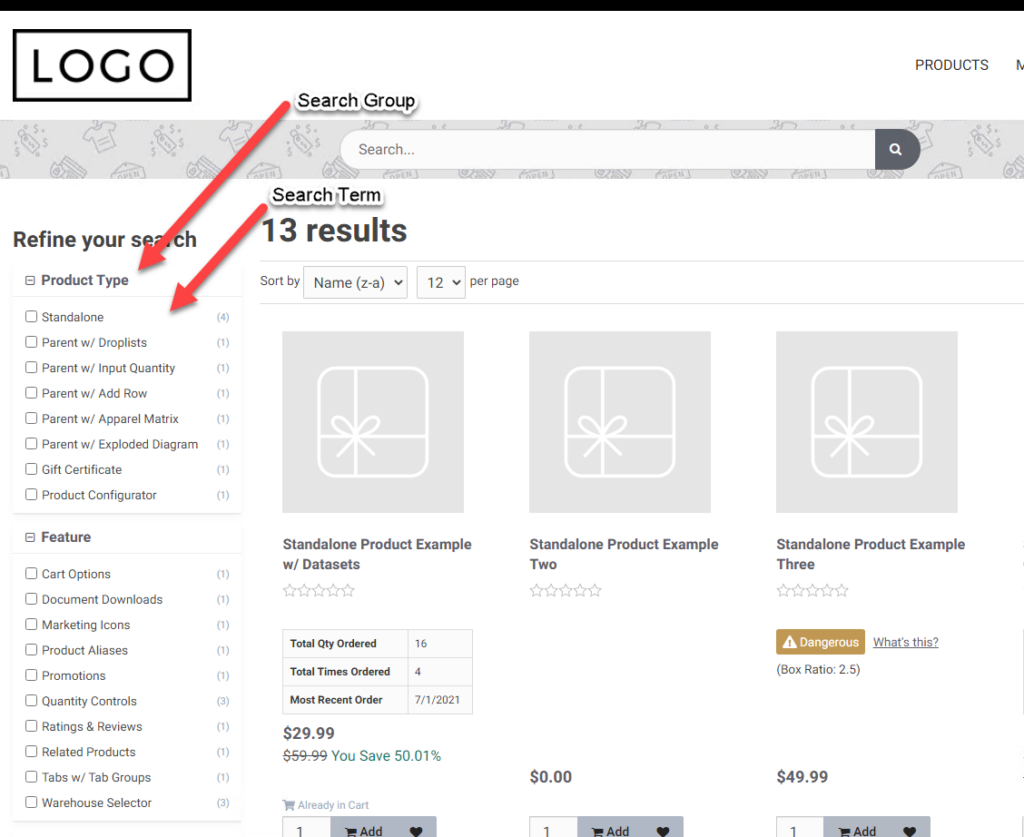
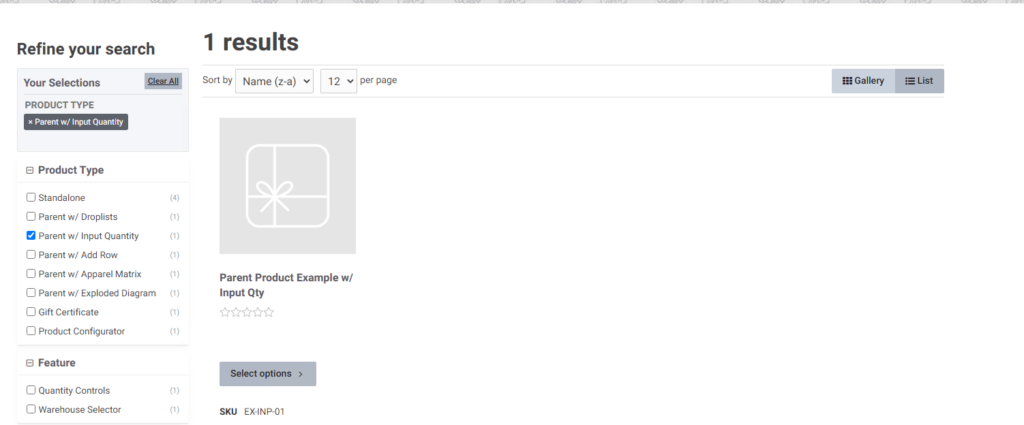
It should be noted that Faceted Search only returns products that are normally available on the search results/category pages. By default this means only parent and standalone products. If you tie a Search Term to a child product it will have no impact on the products returned by Faceted Search since child products do not display by default.
Implementation Strategy
When implementing Faceted Search (Refine Your Search) it is best to develop a strategy before beginning any set-up. This strategy should include the use of categories and parent/child product relationships. It is typically recommended that you limit the use of Parent/Child products since these can limit the effectiveness of Faceted Search. Ideally the product being searched for returns on the search results/category page and you do not have to go into a parent product to further select the desired product. You specifically want to avoid duplicating child options in the faceted Search Terms as this could lead to confusion.
You can set up Categories for high level filtering and then determine the Search Groups that will help users find the specific products they need within those categories. Once this is determined you can define the Search Terms for each Search Group and then assign products to the specific Search Terms. Only if there are still additional attributes that define a product would you use parent/child products.
What a CRM Worker Sees
A CRM user does not interact with Faceted Search directly and will only see what a customer sees when impersonating.
What an Admin Worker Sees
After developing your overall Faceted Search strategy as mentioned above you can manage Faceted Search in the Worker Portal when the Refine Your Search application setting is turned on and the given worker is given access to the Product Workspace.
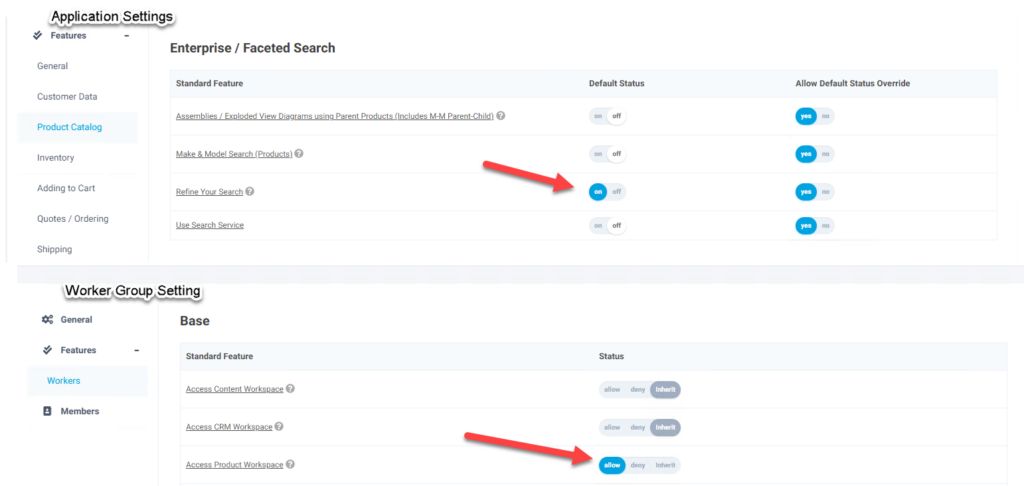
Standard Refine Your Search works off of a file populated on the server based on the Faceted Search set-up in the worker portal. This is done for speed of the return. Any updates or changes to the Faceted Search set-up require this file to be updated. This file is updated by a system process that runs by default every 3 hours.
Search Groups
When Search Terms are created they need to be tied to Search Groups, so Search Groups should be created first. When creating Search Groups on the menu go to Product Workspace > Faceted Search > Search Groups. The manage page shows the existing search groups and there is the option to Add Search Group (this can also be done from the + icon next to Search Groups on the main menu).
The following reviews the available settings for Search Groups. The values in parenthesis are those used when doing csv imports.
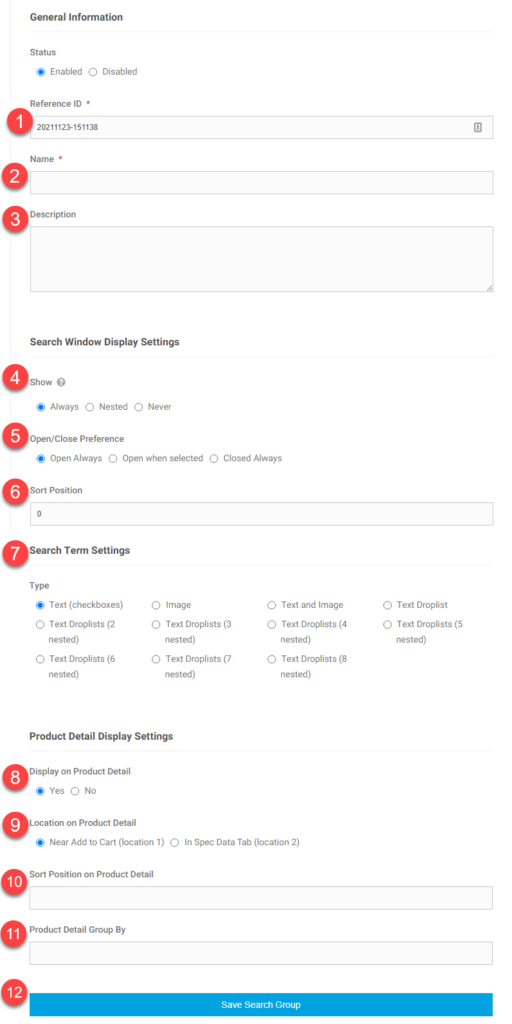
- Reference ID (ref_id) – This is a unique value to identify the specific Search Group and what is used in uploads when tying Search Terms to Search Groups. This does not display to users. Best practice is for these to contain no spaces or special characters.
- Name (nm) – This is what displays to users on the customer site. This too needs to be unique across search groups as having duplicate Search Group names can cause the customer site display to err. If you have different product lines where you have a “Size” attribute, then just include the product line as part of the name (Screw Size and Bolt Size versus just calling both Size).
- Description (ds) – This if for the worker portal only and does not display to customer site users.
- Show (display_when) – The options are:
- Always (general) – This group shows whenever products are return tied to Search Terms tied to this Search Group
- Nested (conditional) – Nested Search Groups only display when a Search Term in another Search Group is selected that has products also tied to Search Terms in this Search Group. This is a way to limit the initial display of Search Groups. This is reviewed in more detail below.
- Never (never) – This turns of the display of this Search Group and the Search Group will not display
- Open/Close Preference (window_display_preference). This determines how the Search Group displays/acts on the customer site. The available options are:
- Open Always (open-always) – When Faceted Search loads this group is expanded and terms are visible.
- Open When Selected (open-when-selected) – The Search Group initially loads with the group display closed and it has to be opened/expanded to see the Search Terms. Once a Search Term is selected it remains open.
- Closed Always (closed-always) – The Search Group loads closed and has to be opened/expanded to see the Search Terms. After a term is selected and the page refreshes the group returns closed.
-
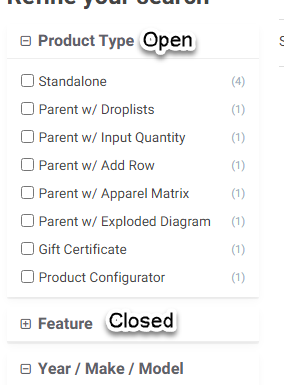
Figure 5 – Groups Open Closed
- Sort Position (general-search-position) – This always you to control the order the search groups display on the page. If this is not populated it defaults to alpha-numeric.
- Search Terms Settings (display_type_in_window) – This controls the display for the specific Search Group. Available options are:
- Text (checkboxes) (text) – This is the standard display where options can be selected with checkboxes as shown in Figure 5 above.
- Image (image) – This option is not currently supported and is for future use.
- Text and Image (text-image) – This option is not currently supported and is for future use.
- Text Droplist (text-droplist) – This uses a droplist versus checkboxes. This limits the selection to one option. This enables additional fields (Droplist Choice Labels) for the label to display in the droplist. When this option is selected only the first Droplist Choice Label, Choice 1 Label (choice1_label)) should be populated. See Figure 6 below for how this displays. This does require corresponding fields on the Search Terms mapped to this Search Group to be populated.
- Text Droplists (2 nested) (text-droplists-2) – This uses nested droplist for the display where the first selection narrows the options available for the next selection and so on. This enables additional fields (Droplist Choice Labels) for the label to display in the droplist. When this option is selected only the first two Droplist Choice Labels, Choice 1 Label (choice1_label) and Choice 2 Label (choice2_label) should be populated. See Figure 6 below for how this displays. This does require corresponding fields on the Search Terms mapped to this Search Group to be populated.
- Text Droplists (3 nested) (text-droplists-3) – This uses nested droplist for the display where the first selection narrows the options available for the next selection and so on. This enables additional fields (Droplist Choice Labels) for the label to display in the droplist. When this option is selected only the first three Droplist Choice Labels, Choice 1 Label (choice1_label), Choice 2 Label (choice2_label), and Choice 3 Label (choice3_label) should be populated. See Figure 6 below for how this displays. This does require corresponding fields on the Search Terms mapped to this Search Group to be populated.
- Text Droplists (4 nested) (text-droplist-4) – This uses a forth droplist following the same philosophy as the ones above.
- Text Droplists (5 nested) (text-droplist-5) – This uses a fifth droplist following the same philosophy as the ones above.
- Text Droplists (6 nested) (text-droplist-6) – Currently not supported
- Text Droplists (7 nested) (text-droplist-7) – Currently not supported
- Text Droplists (8 nested) (text-droplist-8) – Currently not supported
-
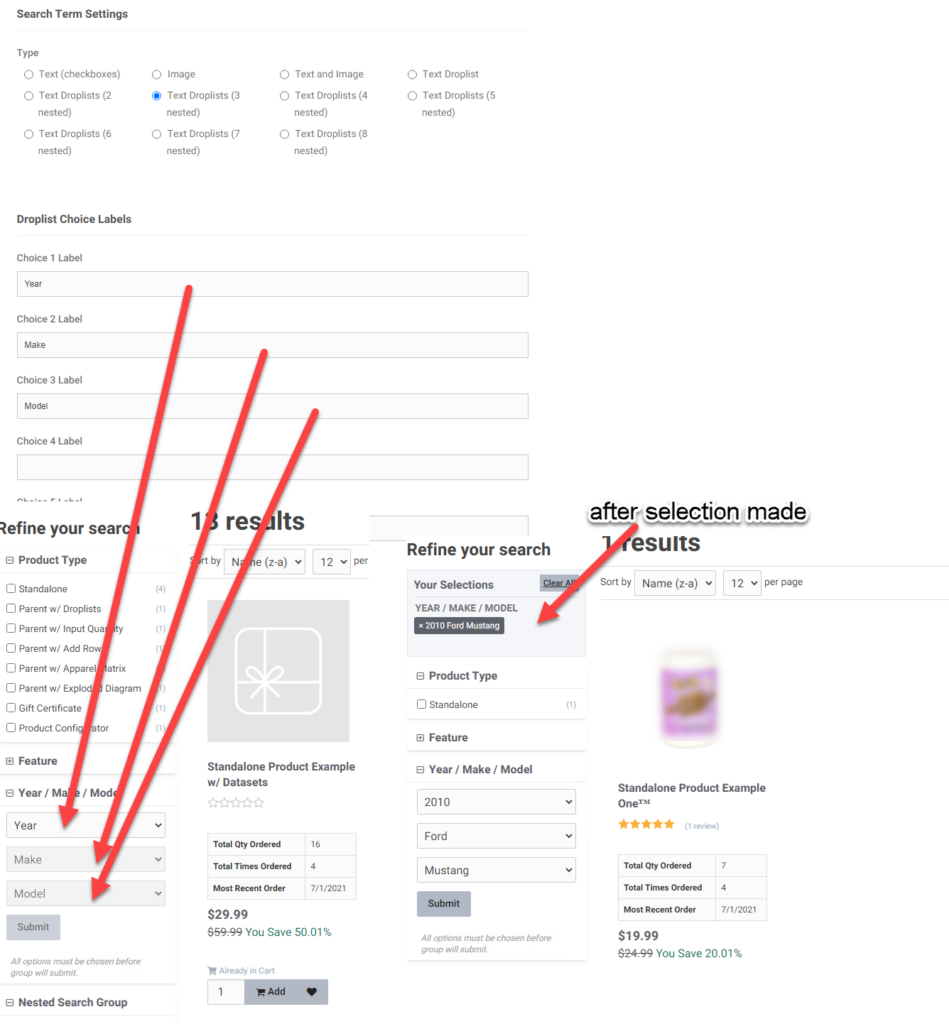
Figure 6 – Nested Droplist Display
8 – 11 Product Detail Display Settings Section – These options are for future functionality and do not currently impact product detail page display.
Nested Search Groups
When the display setting for Show is set to nested it enables a page section where you can set the Parent Search Group for the particular Search Group. Nested Groups can also be managed from the the menu directly from the page Nested Search Groups (see Figure 7).
Nested Search Groups will only display if products tied to one of the Search Terms in the Parent Search Group is also tied to a Search term in the Nested Search Group (Child Search Group)
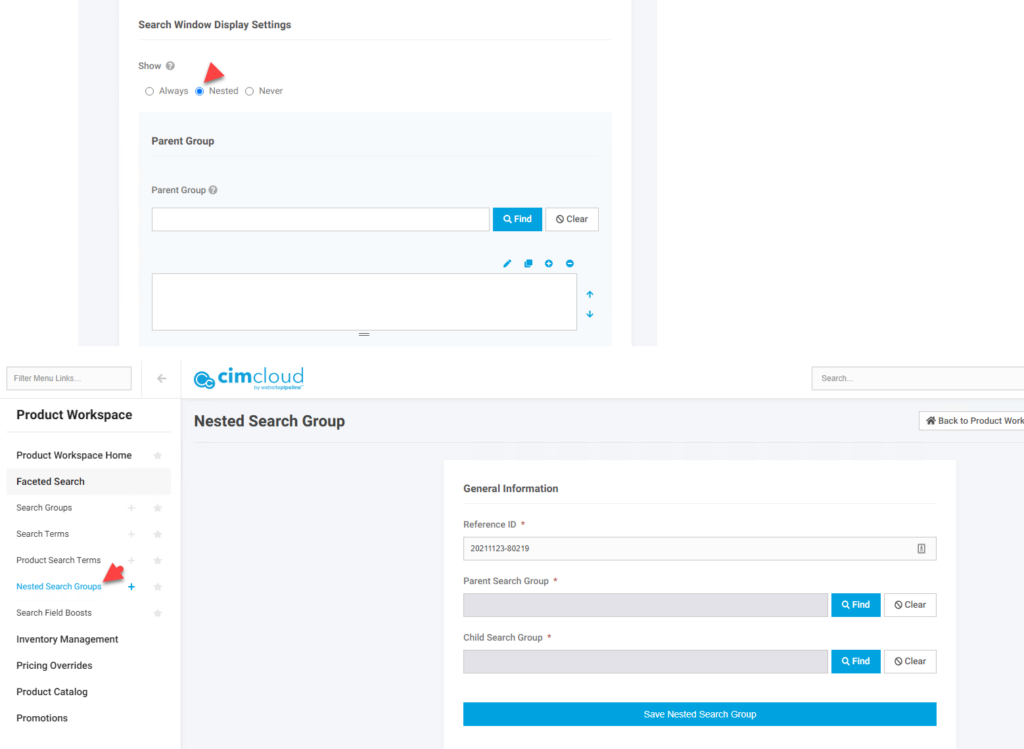
Search Terms
Search Terms are the actual selections the user makes. When creating Search Terms on the menu go to Product Workspace > Faceted Search > Search Terms. The manage page shows the existing search terms and there is the option to Add Search Term (this can also be done from the + icon next to Search Groups on the main menu).
The following reviews the available settings for Search Terms. The values in parenthesis are those used when doing csv imports.
- Reference ID (ref_id) – This is a unique value to identify the specific Search Term and what is used in uploads when referencing the Search Term. This does not display to users. Best practice is for these to contain no spaces or special characters.
- Name/Search Term (nm) – This is what displays to the user on the customer site. The name should be unique within the Search Group but can be shared for Search Terms in Different Search Groups.
- Description (ds) – This is for information only and only displays in the worker portal.
- Search Group (sg_id) – This is the Search Group the Search Term is tied to. All Search Terms must be tied to a Search Group and only one Search Group.
- Sort Position in Search Group (sort_postion) – This is the used to control the display order of Search Terms within a Search Group
- Search Term Position (pos_on_detail) – This is for future dev and does not currently impact the product display.
- Option 1 (opt1) – This is the value in the droplist displayed for this search term when tied to a Search Group using one of the nested droplist options as noted above. The option fields populated should correspond to the number of droplist selected for the Search Group. So if a Search Group is a Droplist 3 then Option1 through Option 3 should be populated on all Search Terms tied to that Search Group.
- Option 2 (opt2) – This is the value in the droplist displayed for this search term when tied to a Search Group using one of the nested droplist options as noted above. The option fields populated should correspond to the number of droplist selected for the Search Group. So if a Search Group is a Droplist 3 then Option1 through Option 3 should be populated on all Search Terms tied to that Search Group.
- Option 3 (opt3) – This is the value in the droplist displayed for this search term when tied to a Search Group using one of the nested droplist options as noted above. The option fields populated should correspond to the number of droplist selected for the Search Group. So if a Search Group is a Droplist 3 then Option1 through Option 3 should be populated on all Search Terms tied to that Search Group.
- Option 4 (opt4) – This is the value in the droplist displayed for this search term when tied to a Search Group using one of the nested droplist options as noted above. The option fields populated should correspond to the number of droplist selected for the Search Group. So if a Search Group is a Droplist 3 then Option1 through Option 3 should be populated on all Search Terms tied to that Search Group.
- Option 5 (opt5) – This is the value in the droplist displayed for this search term when tied to a Search Group using one of the nested droplist options as noted above. The option fields populated should correspond to the number of droplist selected for the Search Group. So if a Search Group is a Droplist 3 then Option1 through Option 3 should be populated on all Search Terms tied to that Search Group.
- Save Search Term – This saves the record. As noted above changes will not be visible until after the system process runs.

Figure 8 – Search Term Set-up
Search Terms to Products
Search Terms will only display if products returned are tied to the specific Search Term. When mapping products to Search Terms on the menu go to Product Workspace > Faceted Search > Product Search Terms. The manage page shows the existing search terms and there is the option to Add Search Term (this can also be done from the + icon next to Search Groups on the main menu).

- Reference ID (ref_id) – This is a unique value to identify the specific Search Term and what is used in uploads when referencing the Search Term. This does not display to users. Best practice is for these to contain no spaces or special characters.
- Product ID (p_id) – This is the product (sku) for the particular product.
- Search Term / Name (std_id) – This is the Search Term you are tying the product to.
- Save – This saves teh record.
Data Import Strategy
When using Faceted Search there is typically a lot of data to manage and using csv imports (Managing Data Through Spreadsheet Imports and Downloading Table Specific Data ) is typically a good way to manage all the data. Since there can be lots of data and the data builds on each other (products are tied to Search Terms which are tied to Search Groups), it is recommended you use a a system for record ref_ids that builds on each other. Set a ref_id on the Search Group that is easily defines the record. Any Search Term you tie to the Search Group should contain the search Group ref_id and an identifier for the specific Search Term. This makes sure the value is unique and is easy to identify. The ref_id for the product to Search Term record should build on this and include the sku for the specific product. Again this makes sure the record is unique and easily identifiable.
For example if you are going to have a Search Group “Product Length” with a Search Term “10 to 12 inches” tied to product “sku1234” the ref_ids would be:
- Search Group: product_length
- Search Term: product_length-10_12_inches
- Search Term to product: product_length-10_12_inches-sku1234
Data Import Templates:
